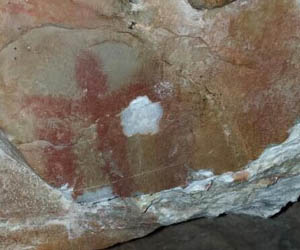Damage in World Heritage Cave Paintings
Saturday, April 26th, 2014 7:30:05 by Jamshed Sindhu
The 5000 years old cave paintings in the Cave School in Santa Elena (Spain), have suffered serious damage after vandals tried to carve out the painting with hammers. The rock painting is part of set of 69 prehistoric rock art sites in the Levantine and Schematic styles, from the mountains of Jaén, Granada and Almeria. UNESCO had declared these sites as World Heritage in 1998.
The Guardia Civil is investigating the damage at this site following a complaint from several visitors who, last weekend, reported that the painting had been damaged by strangers who wanted to tear it from the rock. Painting is spread over five feet wide and long, discovered in 1973 by a group of schoolchildren in St. Helena and where an anthropomorphic swallow with very long arms and a very faint strokes own schematic distinguished period.
The mayor of Santa Elena, Juan Caminero said that the most likely the alleged perpetrators of the destruction are seen surprised by the presence of visitors (many during Holy Week) and leave the place without achieving its purpose of taking these paintings, though they let several scattered pieces of quartzite. The coat is an hour walk from the village of Miranda del Rey. As with most of these sites lack any kind of specific protection, although they are properly marked. “The best protection is to be found within the natural park Despenaperros, whose access is controlled and restricted,” said the mayor.
“These paintings, which are distributed over different coats and hollows of Eastern Sierra Morena, is the finding of special religious and magical value of this area of ??ancient and ancestral step,” said Benito Navarrete, art historian and director of Cultural Infrastructure and heritage of the City of Seville. In his view, it is ” representations that have a clear oriental influence and would be related to religious and sexual rites; the value thereof is therefore very important for their rarity and link these demonstrations with the Mediterranean arc. ” Art expert equated these paintings with those published by Bernier and Fortea (2009) in the cave of bat guano in the province of Cordoba and are usually identified as parietal representations known as idols – plate. Yes, its very difficult not appear dating the lithic and ceramic remains associated with them nor a stratigraphy to be rock shelters or slabs which are reflected.
Navarrete has been one that has sounded the alarm over the lack of protection of these sites. “It is an attack on the heritage and his complaint must be energetic. It is necessary, necessary to protect these shelters with grills or screens so that access is difficult measures. ” In 2006, the Andalusian Federation of Speleology (FAE) noted that 99 % of the prehistoric caves of Andalucía were not protected, and conservation was in danger.
And, the poor state of conservation is the main threat of these rock shelters, caves, dens or ravines where found any figurative representation ranging from geometric patterns to scenes of hunting, gathering, or war dance, including figures human and animal. Municipalities complain that only have resources for maintenance and protection, but are aware that involve a tourist attraction for its municipalities.
Short URL: https://www.newspakistan.pk/?p=43321

















